Rapid PM2.5-Induced Health Impact Assessment: A Novel Approach Using Conditional U-Net CMAQ Surrogate Model
Abstract
1. Introduction
2. Materials and Methods
2.1. Preparing Datasets
2.1.1. Community Multiscale Air Quality
2.1.2. Control Matrix
2.2. Emulating CMAQ Simulation
2.2.1. Conditional U-Net Architecture
2.2.2. Gridding Strategy
2.3. Evaluation Methods
2.3.1. Performance Metrics
2.3.2. Contribution Analysis Using SHAP Value
2.4. Health Impact Assessment
2.4.1. BenMAP-CE Methodology
- Air quality data (monitored or modeled)
- Detailed population demographics
- Baseline health incidence rates
- Concentration-response functions from the epidemiological literature
- Economic valuation methods
2.4.2. Input Parameters of Health Impact Assessment
3. Results
3.1. Emulation Performance Evaluation
3.1.1. Emulation Results
3.1.2. Input Contribution Analysis
3.1.3. Computational Performance
3.2. Health Impact Assessment
4. Discussion and Conclusions
4.1. Development of a CMAQ Emulator Using a Conditional U-Net
4.2. Health Impact Assessment and Policy Implications
4.3. Limitations and Future Research
4.4. Overall Summary and Conclusions
Supplementary Materials
Author Contributions
Funding
Institutional Review Board Statement
Informed Consent Statement
Data Availability Statement
Conflicts of Interest
Abbreviations
| BenMAP | Environmental Benefits Mapping and Analysis Program |
| CMAQ | Community Multiscale Air Quality Modeling System |
| CNN | Convolutional Neural Networks |
| CPU | Central Processing Unit |
| CVD | Cardiovascular diseases |
| EPA | Environmental Protection Agency |
| GPU | Graphics Processing Unit |
| KOSIS | Korean Statistical Information Service |
| LHS | Latin Hypercube Sampling |
| MAE | Mean Absolute Error |
| Ammonia | |
| NMAE | Normalized Mean Absolute Error |
| Nitrogen oxides | |
| Particulate matter with diameter less than 2.5 μm | |
| RD | Respiratory diseases |
| SHAP | SHapley Additive exPlanations |
| Sulfur dioxide | |
| VOC | Volatile Organic Compounds |
| WHO | World Health Organization |
References
- World Health Organization. WHO Global Air Quality Guidelines: Particulate Matter (PM2.5 and PM10), Ozone, Nitrogen Dioxide, Sulfur Dioxide and Carbon Monoxide. 2021. Available online: https://apps.who.int/iris/handle/10665/345329 (accessed on 1 September 2024).
- European Environment Agency. Air Quality in Europe 2022. 2022. Available online: https://www.eea.europa.eu/publications/air-quality-in-europe-2022 (accessed on 1 September 2024).
- Yu, W.; Xu, R.; Ye, T.; Abramson, M.J.; Morawska, L.; Jalaludin, B.; Johnston, F.H.; Henderson, S.B.; Knibbs, L.D.; Morgan, G.G.; et al. Estimates of global mortality burden associated with short-term exposure to fine particulate matter (PM2.5). Lancet Planet. Health 2024, 8, e146–e155. [Google Scholar] [CrossRef] [PubMed]
- Han, S.; Park, Y.; Noh, N.; Kim, J.H.; Kim, J.J.; Kim, B.M.; Choi, W. Spatiotemporal variability of the PM2.5 distribution and weather anomalies during severe pollution events: Observations from 462 air quality monitoring stations across South Korea. Atmos. Pollut. Res. 2023, 14, 101676. [Google Scholar] [CrossRef]
- Byun, G.; Kim, S.; Choi, Y.; Kim, A.; AiMS-CREATE Team; Lee, J.T.; Bell, M.L. Long-term exposure to (PM2.5) and mortality in a national cohort in South Korea: Effect modification by community deprivation, medical infrastructure, and greenness. BMC Public Health 2024, 24, 1266. [Google Scholar] [CrossRef] [PubMed]
- Kumar, N.; Park, R.J.; Jeong, J.I.; Woo, J.H.; Kim, Y.; Johnson, J.; Yarwood, G.; Kang, S.; Chun, S.; Knipping, E. Contributions of international sources to PM2.5 in South Korea. Atmos. Environ. 2021, 261, 118542. [Google Scholar] [CrossRef]
- Allabakash, S.; Lim, S.; Chong, K.S.; Yamada, T.J. Particulate Matter Concentrations over South Korea: Impact of Meteorology and Other Pollutants. Remote Sens. 2022, 14, 4849. [Google Scholar] [CrossRef]
- Kumar, N.; Johnson, J.; Yarwood, G.; Woo, J.H.; Kim, Y.; Park, R.J.; Jeong, J.I.; Kang, S.; Chun, S.; Knipping, E. Contributions of domestic sources to PM2.5 in South Korea. Atmos. Environ. 2022, 287, 119273. [Google Scholar] [CrossRef]
- Cha, Y.; Song, C.K.; Jeon, K.H.; Yi, S.M. Factors affecting recent PM2.5 concentrations in China and South Korea from 2016 to 2020. Sci. Total Environ. 2023, 881, 163524. [Google Scholar] [CrossRef]
- National Assembly Budget Office. Analysis of Air Quality and Budget Allocation in South Korea. 2019. Available online: https://korea.nabo.go.kr/ (accessed on 23 August 2024).
- Special Act on the Reduction and Managementof Fine Dust Act of 2018. §33491. 2018. Available online: https://elaw.klri.re.kr/eng_mobile/viewer.do?hseq=50524&type=sogan&key=16 (accessed on 23 August 2024).
- US EPA Office of Research and Development. CMAQ: The Community Multiscale Air Quality Modeling System; US EPA Office of Research and Development: Research Triangle Park, NC, USA, 2022. Available online: https://www.epa.gov/cmaq (accessed on 1 September 2024).
- Gao, Z.; Zhou, X. A review of the CAMx, CMAQ, WRF-Chem and NAQPMS models: Application, evaluation and uncertainty factors. Environ. Pollut. 2024, 343, 123183. [Google Scholar] [CrossRef]
- Xing, J.; Wang, S.X.; Jang, C.; Zhu, Y.; Hao, J.M. Nonlinear response of ozone to precursor emission changes in China: A modeling study using response surface methodology. Atmos. Chem. Phys. 2011, 11, 5027–5044. [Google Scholar] [CrossRef]
- Wang, S.; Xing, J.; Jang, C.; Zhu, Y.; Fu, J.S.; Hao, J. Impact Assessment of Ammonia Emissions on Inorganic Aerosols in East China Using Response Surface Modeling Technique. Environ. Sci. Technol. 2011, 45, 9293–9300. [Google Scholar] [CrossRef]
- Xing, J.; Ding, D.; Wang, S.; Zhao, B.; Jang, C.; Wu, W.; Zhang, F.; Zhu, Y.; Hao, J. Quantification of the enhanced effectiveness of NOx control from simultaneous reductions of VOC and NH3 for reducing air pollution in the Beijing–Tianjin–Hebei region, China. Atmos. Chem. Phys. 2018, 18, 7799–7814. [Google Scholar] [CrossRef]
- Xing, J.; Zheng, S.; Ding, D.; Kelly, J.T.; Wang, S.; Li, S.; Qin, T.; Ma, M.; Dong, Z.; Jang, C.; et al. Deep Learning for Prediction of the Air Quality Response to Emission Changes. Environ. Sci. Technol. 2020, 54, 8589–8600. [Google Scholar] [CrossRef] [PubMed]
- Xu, J.Z.; Zhang, H.R.; Cheng, Z.; Liu, J.Y.; Xu, Y.Y.; Wang, Y.C. Approximating Three-Dimensional (3-D) Transport of Atmospheric Pollutants via Deep Learning. Earth Space Sci. 2022, 9, e2022EA002338. [Google Scholar] [CrossRef]
- Salman, A.K.; Choi, Y.; Park, J.; Mousavinezhad, S.; Payami, M.; Momeni, M.; Ghahremanloo, M. Deep learning based emulator for simulating CMAQ surface NO2 levels over the CONUS. Atmos. Environ. 2024, 316, 120192. [Google Scholar] [CrossRef]
- Sacks, J.D.; Lloyd, J.M.; Zhu, Y.; Anderton, J.; Jang, C.J.; Hubbell, B.; Fann, N. The Environmental Benefits Mapping and Analysis Program - Community Edition (BenMAP-CE): A tool to estimate the health and economic benefits of reducing air pollution. Environ. Model. Softw. 2018, 104, 118–129. [Google Scholar] [CrossRef]
- Sacks, J.; Coffman, E.; Rappold, A.G.; Anderton, J.; Amend, M.; Baker, K.; Fann, N. A Proof-Of-Concept Approach for Quantifying Multipollutant Health Impacts Using Joint Effects Models within the Open-Source BenMAP-CE Software Program. ISEE Conf. Abstr. 2018, 2018. [Google Scholar] [CrossRef]
- Ho, J.; Jain, A.; Abbeel, P. Denoising Diffusion Probabilistic Models. arXiv 2020, arXiv:2006.11239. [Google Scholar]
- Rombach, R.; Blattmann, A.; Lorenz, D.; Esser, P.; Ommer, B. High-Resolution Image Synthesis with Latent Diffusion Models. arXiv 2021, arXiv:2112.10752. [Google Scholar]
- Ministry of the Interior and Safety, Korea. Ministry of Land, Infrastructure, and Transport Continental Map. 2017. Available online: https://www.data.go.kr/data/15056910/openapi.do (accessed on 30 April 2024).
- Lundberg, S.; Lee, S.I. A Unified Approach to Interpreting Model Predictions. arXiv 2017, arXiv:1705.07874. [Google Scholar]
- Vega García, M.; Aznarte, J.L. Shapley additive explanations for NO2 forecasting. Ecol. Inform. 2020, 56, 101039. [Google Scholar] [CrossRef]
- Stirnberg, R.; Cermak, J.; Kotthaus, S.; Haeffelin, M.; Andersen, H.; Fuchs, J.; Kim, M.; Petit, J.E.; Favez, O. Meteorology-driven variability of air pollution (PM1) revealed with explainable machine learning. Atmos. Chem. Phys. 2021, 21, 3919–3948. [Google Scholar] [CrossRef]
- Li, X.; Wu, C.; Meadows, M.E.; Zhang, Z.; Lin, X.; Zhang, Z.; Chi, Y.; Feng, M.; Li, E.; Hu, Y. Factors Underlying Spatiotemporal Variations in Atmospheric PM2.5 Concentrations in Zhejiang Province, China. Remote Sens. 2021, 13, 3011. [Google Scholar] [CrossRef]
- Li, T.; Zhang, Q.; Peng, Y.; Guan, X.; Li, L.; Mu, J.; Wang, X.; Yin, X.; Wang, Q. Contributions of various driving factors to air pollution events: Interpretability analysis from Machine learning perspective. Environ. Int. 2023, 173, 107861. [Google Scholar] [CrossRef] [PubMed]
- Wu, C.D.; Zhu, J.J.; Hsu, C.Y.; Shie, R.H. Quantifying source contributions to ambient NH3 using Geo-AI with time lag and parcel tracking functions. Environ. Int. 2024, 185, 108520. [Google Scholar] [CrossRef] [PubMed]
- Statistics Korea. Population Projections for Korea, Projected Population by Age (Province). 2024. Available online: https://kosis.kr/statHtml/statHtml.do?orgId=101&tblId=DT_1BPB001&conn_path=I2 (accessed on 12 August 2024).
- Statistics Korea. Causes of Death Statistics, Deaths and Death rates by Cause (104 Item), Sex, and Age (Five-Year Age): Province. 2022. Available online: https://kosis.kr/statHtml/statHtml.do?orgId=101&tblId=DT_1B34E11&conn_path=I2 (accessed on 12 August 2024).
- Hoek, G.; Krishnan, R.M.; Beelen, R.; Peters, A.; Ostro, B.; Brunekreef, B.; Kaufman, J.D. Long-term air pollution exposure and cardio- respiratory mortality: A review. Environ. Health 2013, 12, 43. [Google Scholar] [CrossRef]
- WHO. AirQ+: Software Tool for Health Risk Assessment of Air Pollution. 2018. Available online: https://www.who.int/europe/tools-and-toolkits/airq---software-tool-for-health-risk-assessment-of-air-pollution (accessed on 2 October 2018).
- Baek, J.Y. Contributions of Domestic and Foreign Emissions to High PM2.5 Concentrations in Urban and Background Areas in Korea. Master’s Thesis, Jeju National University, Jeju City, Republic of Korea, 2023. Available online: https://oak.jejunu.ac.kr/handle/2020.oak/24548 (accessed on 1 September 2024).
- Thunis, P.; Clappier, A.; Beekmann, M.; Putaud, J.P.; Cuvelier, C.; Madrazo, J.; de Meij, A. Non-linear response of PM2.5 to changes in NOx and NH3 emissions in the Po basin (Italy): Consequences for air quality plans. Atmos. Chem. Phys. 2021, 21, 9309–9327. [Google Scholar] [CrossRef]
- Kelly, J.T.; Jang, C.; Zhu, Y.; Long, S.; Xing, J.; Wang, S.; Murphy, B.N.; Pye, H.O.T. Predicting the Nonlinear Response of PM2.5 and Ozone to Precursor Emission Changes with a Response Surface Model. Atmosphere 2021, 12, 1044. [Google Scholar] [CrossRef]
- US EPA Office of Research and Development. CMAQv4.7.1; US EPA Office of Research and Development: Research Triangle Park, NC, USA, 2017. [CrossRef]
- Abadi, M.; Agarwal, A.; Barham, P.; Brevdo, E.; Chen, Z.; Citro, C.; Corrado, G.S.; Davis, A.; Dean, J.; Devin, M.; et al. TensorFlow: Large-Scale Machine Learning on Heterogeneous Systems. 2015. Available online: https://www.tensorflow.org/ (accessed on 1 September 2024).
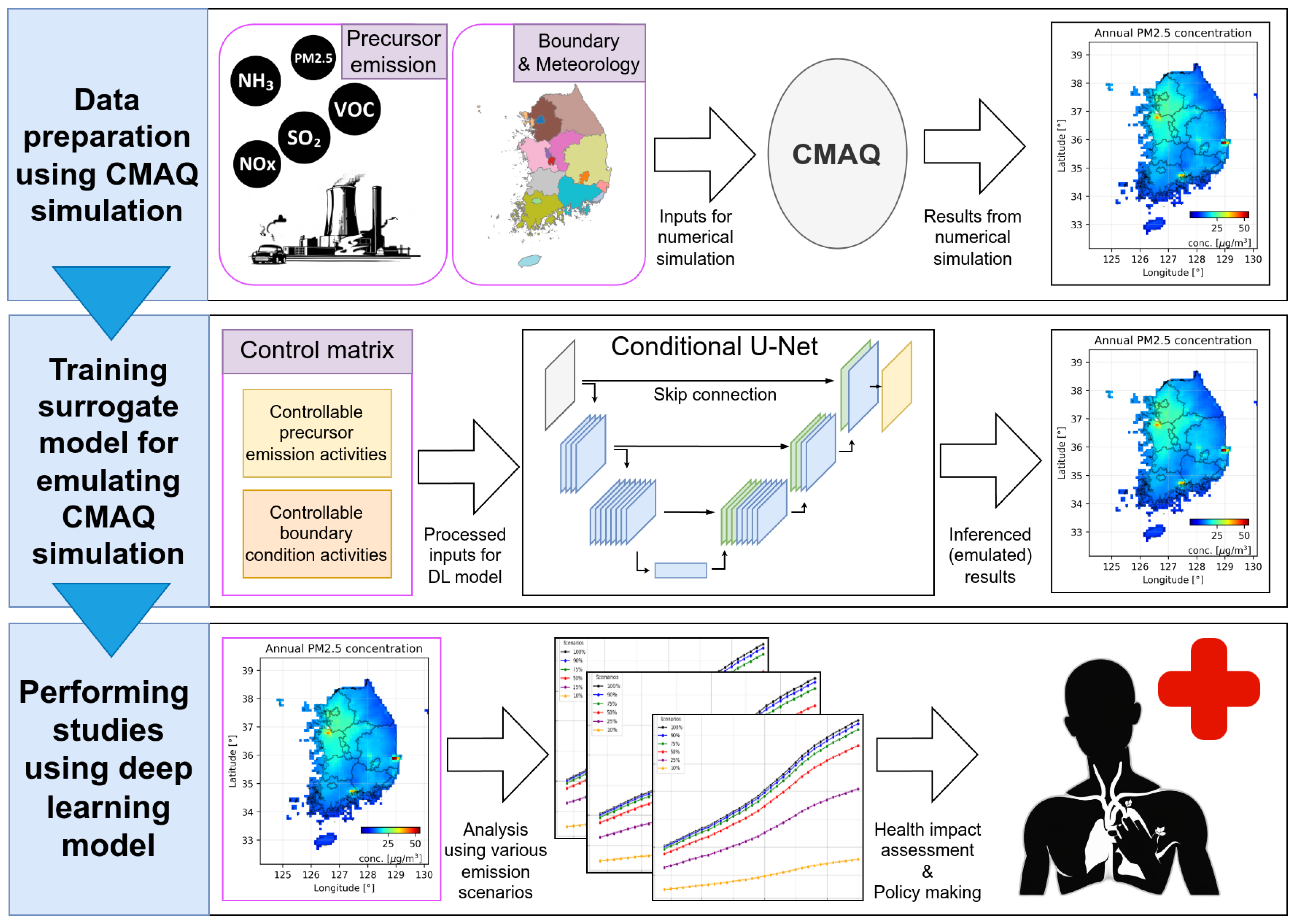
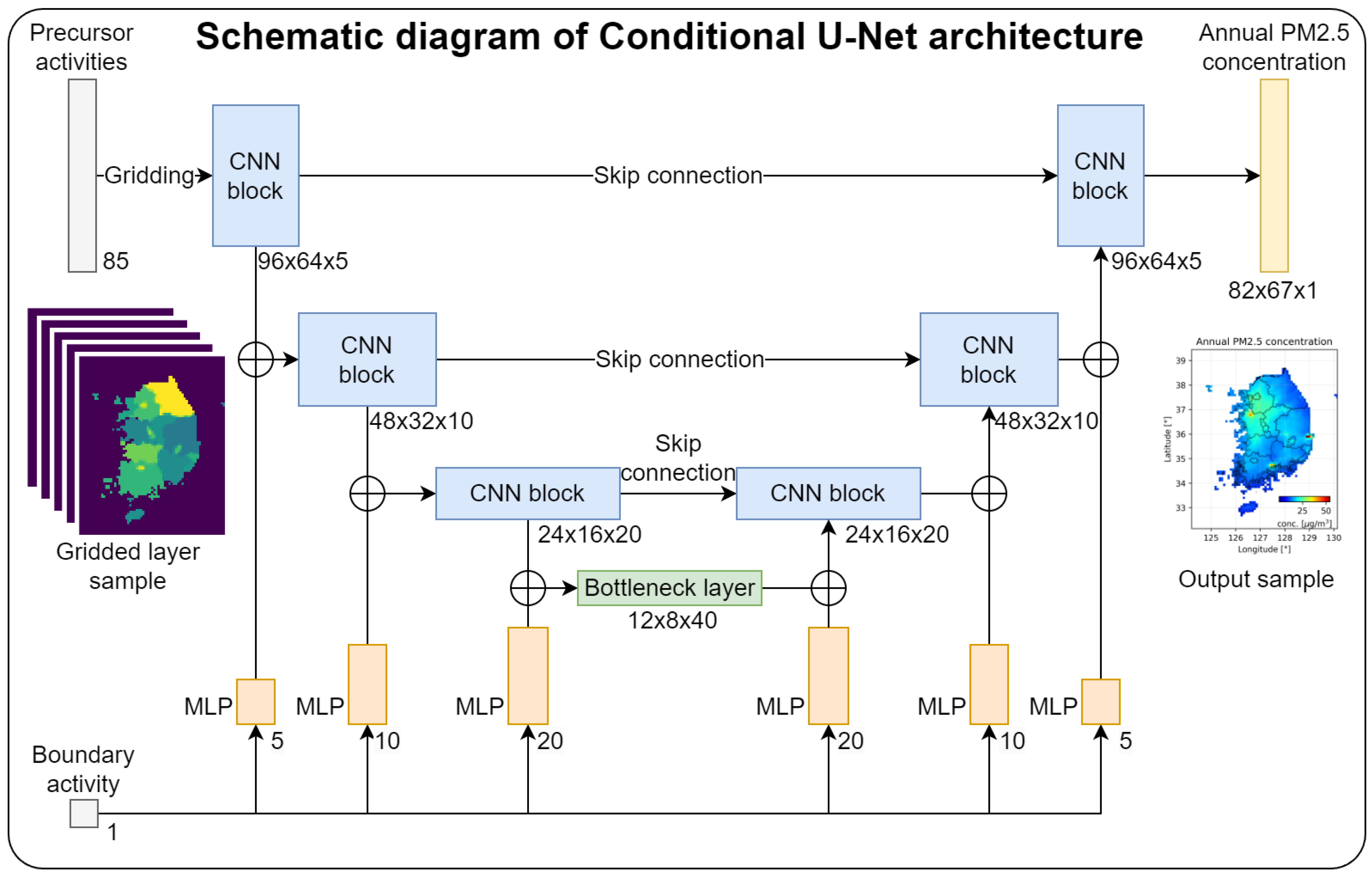

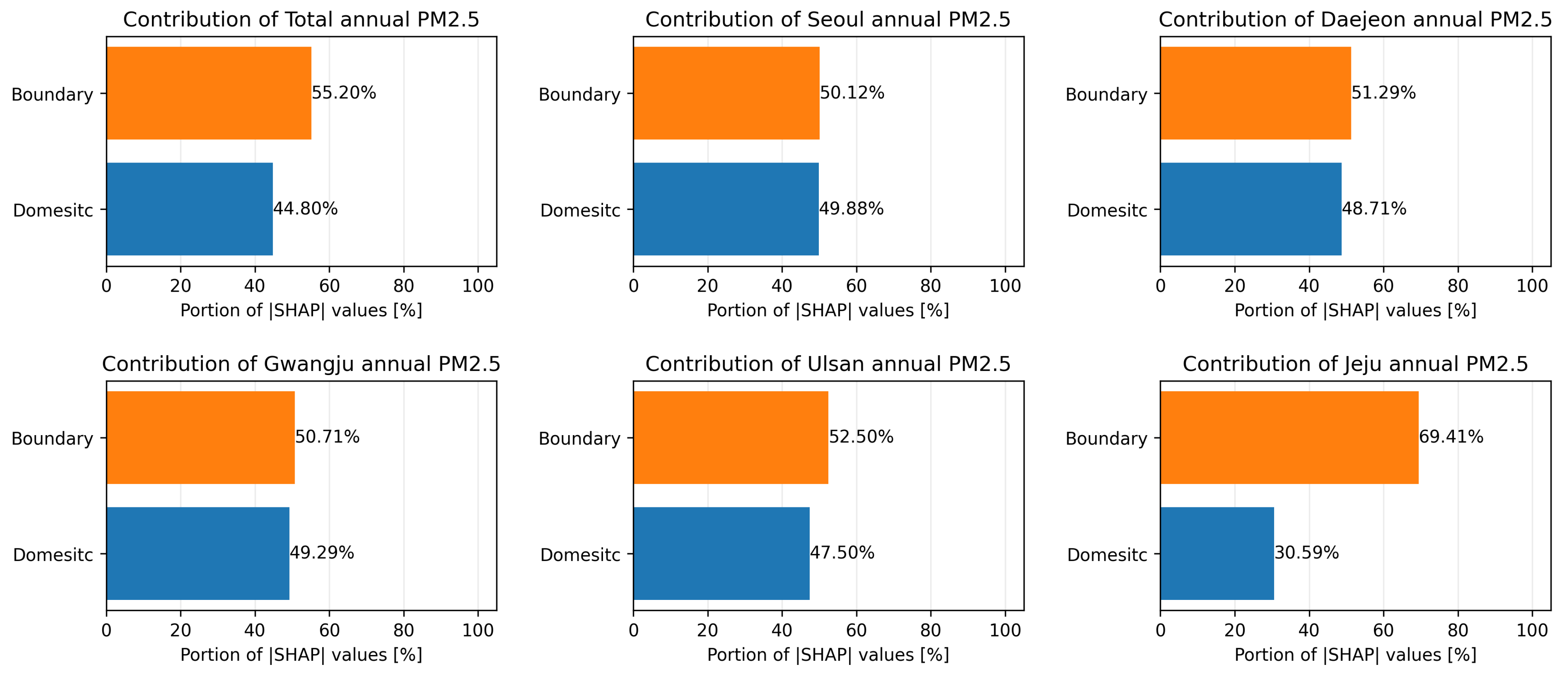
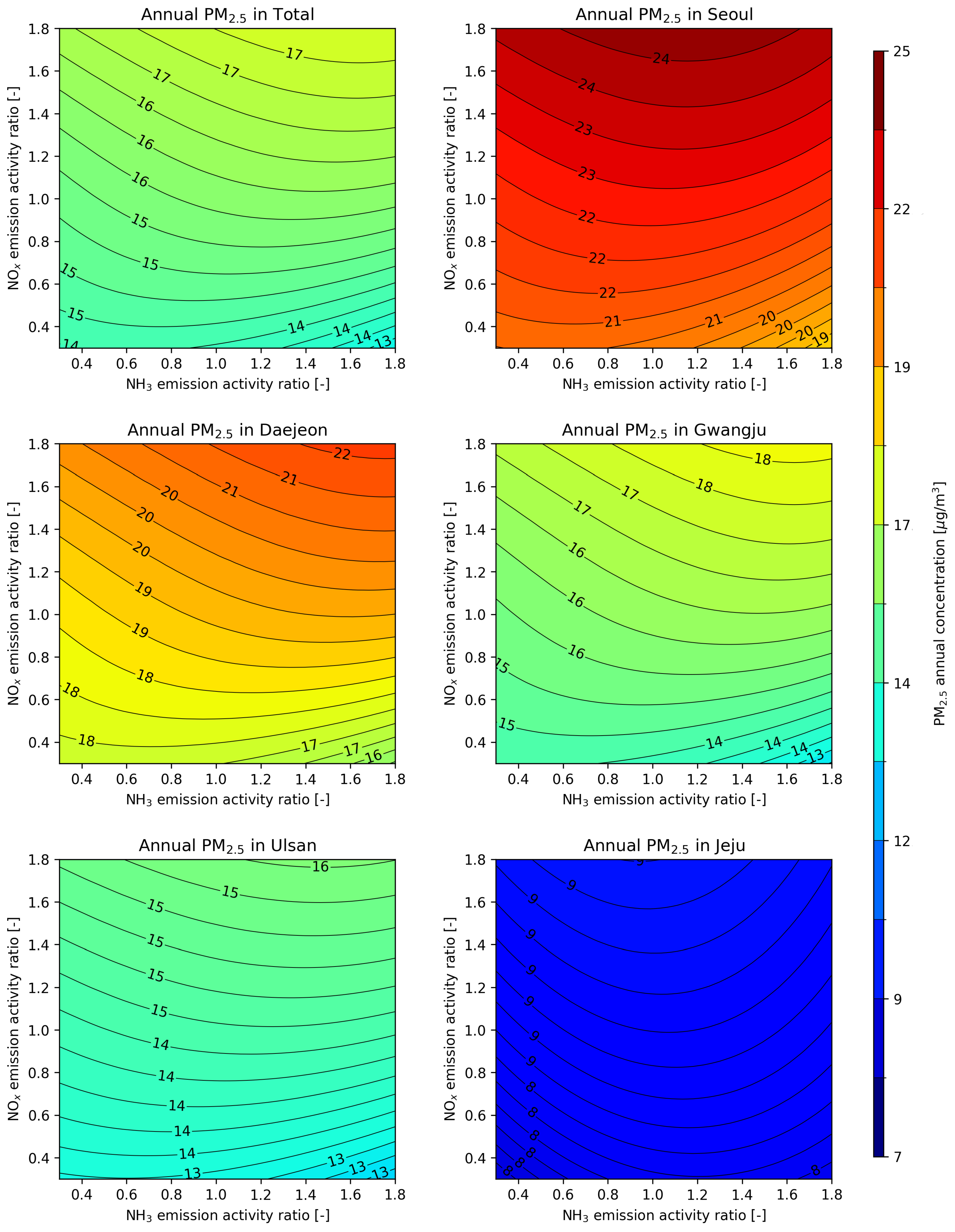
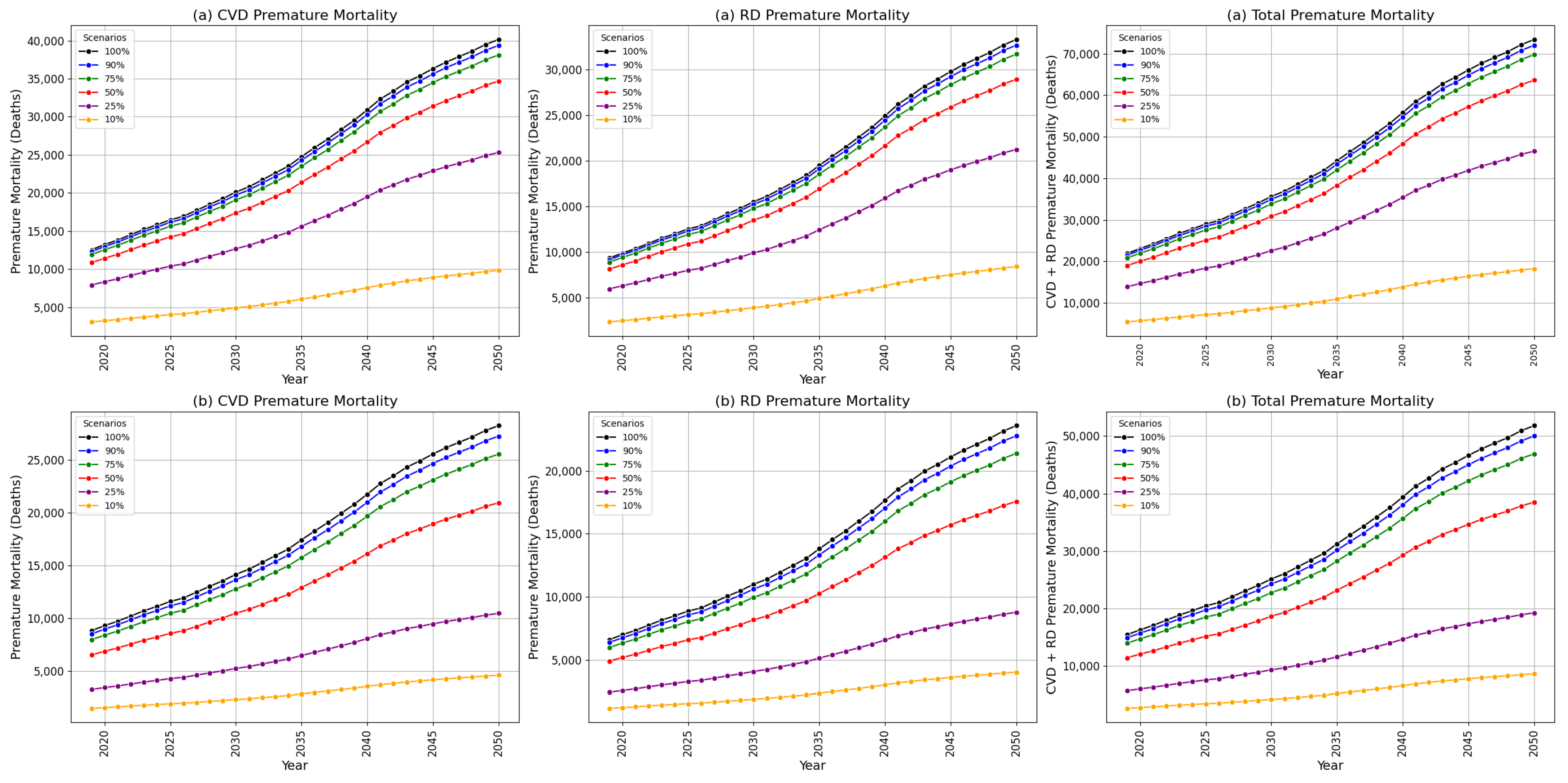
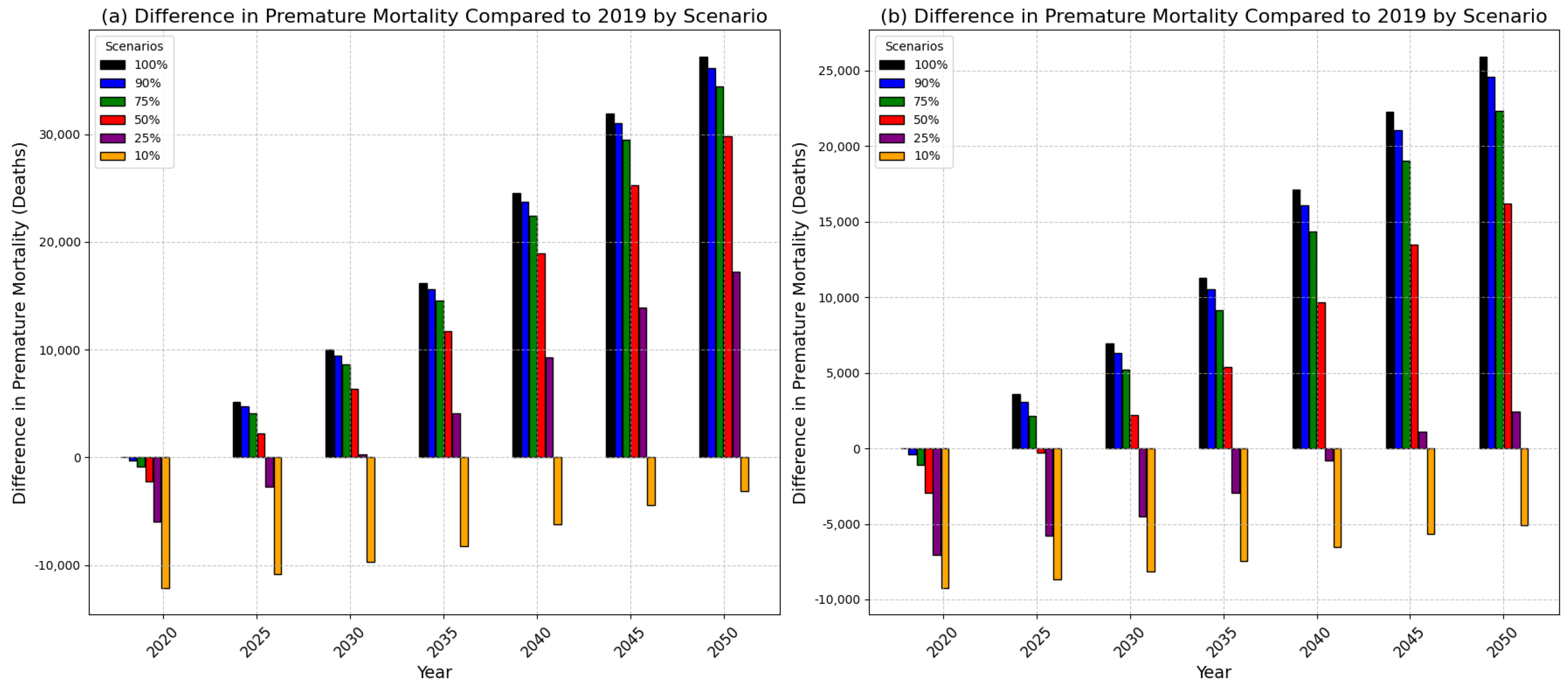

| Region Name | VOC | Activity | ||||
|---|---|---|---|---|---|---|
| Seoul | 0.514 | 0.927 | 0.945 | 0.692 | 1.109 | - |
| Incheon | 0.611 | 1.087 | 0.949 | 0.546 | 0.778 | - |
| Busan | 0.504 | 1.364 | 1.046 | 1.192 | 1.249 | - |
| Daegu | 1.274 | 0.951 | 0.708 | 1.247 | 0.786 | - |
| Gwangju | 0.872 | 1.069 | 0.621 | 0.840 | 1.497 | - |
| Gyeonggi-do | 0.574 | 1.379 | 1.436 | 0.842 | 1.177 | - |
| Gangwon-do | 1.479 | 1.167 | 0.540 | 1.098 | 1.173 | - |
| Chungbuk-do | 1.134 | 0.710 | 0.725 | 1.410 | 0.503 | - |
| Chungnam-do | 0.520 | 0.562 | 0.812 | 1.021 | 0.994 | - |
| Gyeongbuk-do | 1.063 | 1.073 | 1.192 | 1.343 | 1.045 | - |
| Gyeongnam-do | 0.581 | 1.337 | 1.057 | 0.811 | 0.671 | - |
| Jeonbuk-do | 0.702 | 1.286 | 0.580 | 1.150 | 1.063 | - |
| Jeonnam-do | 1.311 | 1.187 | 1.001 | 1.281 | 0.805 | - |
| Jeju-do | 1.034 | 1.224 | 1.395 | 0.520 | 0.752 | - |
| Daejeon | 1.173 | 0.718 | 1.386 | 0.762 | 0.864 | - |
| Ulsan | 1.197 | 0.919 | 0.528 | 1.284 | 0.534 | - |
| Sejong | 0.996 | 1.394 | 0.549 | 0.787 | 1.343 | - |
| Boundary | - | - | - | - | - | 1.000 |
| Target Year | Target Region | Metrics [Units] | Data Category | Score |
|---|---|---|---|---|
| 2019 | South Korea | MAE [μ] | Training set | 0.222 |
| Test set | 0.221 | |||
| NMAE [%] | Training set | 1.788 | ||
| Test set | 1.762 | |||
| [-] | Training set | 0.996 | ||
| Test set | 0.996 |
| Method | Processor | Batch Size | Time Consumed |
|---|---|---|---|
| CMAQ v4.7 | CPU (simulation) | - | ∼24 h/scenario |
| Conditional U-Net | CPU (training) | 256 | ∼10 s/epoch |
| GPU (training) | 256 | ∼1 s/epoch | |
| CPU (prediction) | 32 | ∼10 ms/scenario | |
| GPU (prediction) | 32 | ∼1 ms/scenario |
Disclaimer/Publisher’s Note: The statements, opinions and data contained in all publications are solely those of the individual author(s) and contributor(s) and not of MDPI and/or the editor(s). MDPI and/or the editor(s) disclaim responsibility for any injury to people or property resulting from any ideas, methods, instructions or products referred to in the content. |
© 2024 by the authors. Licensee MDPI, Basel, Switzerland. This article is an open access article distributed under the terms and conditions of the Creative Commons Attribution (CC BY) license (https://creativecommons.org/licenses/by/4.0/).
Share and Cite
Lee, Y.; Park, J.; Kim, J.; Woo, J.-H.; Lee, J.-H. Rapid PM2.5-Induced Health Impact Assessment: A Novel Approach Using Conditional U-Net CMAQ Surrogate Model. Atmosphere 2024, 15, 1186. https://doi.org/10.3390/atmos15101186
Lee Y, Park J, Kim J, Woo J-H, Lee J-H. Rapid PM2.5-Induced Health Impact Assessment: A Novel Approach Using Conditional U-Net CMAQ Surrogate Model. Atmosphere. 2024; 15(10):1186. https://doi.org/10.3390/atmos15101186
Chicago/Turabian StyleLee, Yohan, Junghyun Park, Jinseok Kim, Jung-Hun Woo, and Jong-Hyeon Lee. 2024. "Rapid PM2.5-Induced Health Impact Assessment: A Novel Approach Using Conditional U-Net CMAQ Surrogate Model" Atmosphere 15, no. 10: 1186. https://doi.org/10.3390/atmos15101186
APA StyleLee, Y., Park, J., Kim, J., Woo, J.-H., & Lee, J.-H. (2024). Rapid PM2.5-Induced Health Impact Assessment: A Novel Approach Using Conditional U-Net CMAQ Surrogate Model. Atmosphere, 15(10), 1186. https://doi.org/10.3390/atmos15101186





